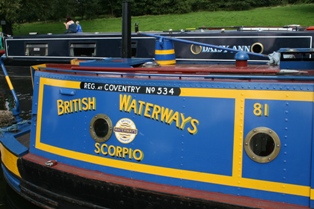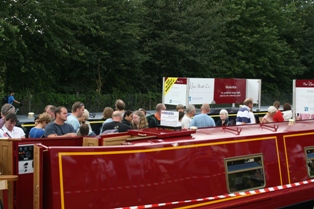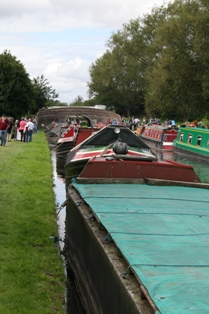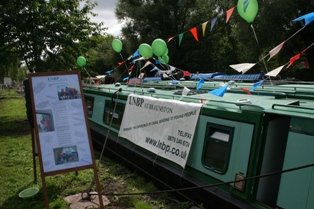
Boats and boaters gathered for the IWA national festival
Making the cut, part two
As part of his investigation into the people and politics of the UK waterways system Mick Owen spent a day at the Inland Waterways Association’s national get-together in and around Autherley Junction in Wolverhampton.

Boats and boaters gathered for the IWA national festival
There are some things that are quintessentially English, such as the sound of leather on willow, warm beer and self-deprecation. To this list I would suggest we add canal festivals. I have only been to one, of course, but something tells me I have seen a template and that the key ingredients of boats, eccentric entertainment and an air of contentment are pretty much standard.
Bank holiday weekend is a strange time to volunteer to drive into the West Midlands conurbation but nonetheless my photographer and I did risk the M6 and its tributaries, arriving in Wolverhampton duly vexed, over-heated and in no mood for suffering fools. But when the car park man invited us to “pop your car over there and the buzz is round the corner” some of the steam was released. When the buzz turned out to be a double-decker with plenty of room on top, and the father and son in the front seats were sporting gaiters and be-ribboned straw trilbies, a sense of calm began to descend. Your correspondent is not one of nature’s queuers so finding a gate for “pre-paid tickets and passes” meant that by the time entrance was effected a degree of equanimity had been restored.
The Inland Waterways Association (IWA) move their national festival around the country and were marketing the 2008 vintage as the Black Country Waterways Festival, hoping no doubt to maximise the number of visitors by pulling in the family trade. As the festival’s marketing director, Gillian Bolt, explained, bringing the event into the proximity of such a densely populated part of Britain both increased its potential audience and its competition: “Last year the festival was in St Ives in Cambridgeshire where there is simply less going on. This year there are so many other things that people can go to in easy travelling distance.” And it is clear that the success of the festival is to be judged in visitor numbers and that those visitors are expected to be a mix of festival veterans, prospective boat (and boat bits) buyers, the waterways-curious and people looking for “a good day out locally”. How else do you explain the falconry display, the clowning workshop and the blessed Morris men?
What is less obvious is that once they have them through the gates the IWA are keen that the ‘passing trade’ pass on knowing and perhaps caring a little more about the waterways because at its roots the IWA is a pressure group. Formed in 1946 at a time when local authorities were not just ignoring their canals but were actively filling them in, the IWA has worked tirelessly to protect, restore and maintain the inland waterways of England and Wales. These days they lobby government and navigation authorities, contest hundreds of planning applications, provide advice and guidance on restoration, campaign to save and restore all types of waterway and have their own ‘para-military wing’ – the Waterway Recovery Group (WRG) – who, to quote their chairman Mike Palmer, “shovel muck, build bridges, trim hedges [and] do whatever needs doing” to physically restore and maintain all things inland waterway. The WRG are in evidence throughout the festival site, revelling in their role of “putting things up, taking things down, shovelling up mud, putting down straw” – and all for nothing.
Perhaps the single most remarkable piece of information about this long weekend of waterway-inspired business and bonhomie (there are fifty or more real ales available) is that it’s all done by volunteers. In fact – and please bear in mind that I got this from their marketing material – it’s the “largest non-commercial event in the United Kingdom, organised and run by volunteers” and “the biggest inland waterways show in Europe”. There are over three hundred of the beggars, with the majority being over 60 and retired but still offering skills from book-keeping to carpentry, from scaffolding to communications. And they are all courteous, friendly and keen to help the more than 23,000 people whose feet fell in Autherley over the three days. The place, though damp underfoot, is an oasis.
But the problem with a press pass is that you feel constrained to have a little ferret for the real story, to ‘find the angle’. Over three hundred boats, from the 1936 butty Angel to the brand new, not-even-on-the-water-yet, widebeam Valentine, are all well and good; being able to purchase everything from an engine to an aga in a field in Wolverhampton is intriguing enough; but what about the under-belly of the boating business? Is British Waterways playing Polyanna in their annual report where everything is painted in shades of rose; or are the tales of boat-builders going bust as Polish boats add to the over-supply problem caused by uncommitted boat owners unloading as the recession bites a more accurate image?
So I asked the people who were working for wages or for profit about the state of business in the world of waterways. A man who sells shares in narrowboats said that business was brisk as people invested in an alternative to expensive holidays abroad. A woman with a small hiring company was upbeat as bookings were holding up, although the waterways were quieter than usual around her East Anglian base. The volunteer at the pontoon where the new boats were moored reckoned that the crush of people making it impossible to get a word with any sales executive worth her or his salt had been there all weekend. The only dissenting voice came from a broker of formerly loved boats who, while “not struggling”, had experienced a significant drop in sales and interest. Everyone else seemed cheerful enough, although how many coracles got shifted and how many £160 watering cans were sold remain unknowns.
What is known, though, is that when it comes to money – in terms of investment – there isn’t enough about. In his festival welcome IWA chair John Fletcher did not mince words: “The funding available from government to support waterways is decreasing and is insufficient to maintain a safe and vibrant system. And yet sustaining a vibrant waterway system benefits very wide sections of the community and fulfils many government agendas.” And then he makes a very salient point: “Mechanisms which recognise and link those who bear the burden of cost with those who benefit have to be found.” Sharing the same platform, British Waterways chairman Tony Hales contented himself with praising the volunteer effort, listing the entertainment, which included an outfit offering jazz-samba, and a line about the beer tent.
Mick Owen is managing editor of The Leisure Review
Making the cut, part one can be found in the August issue of The Leisure Review via the features page
The Leisure Review, September 2008
© Copyright of all material on this site is retained by The Leisure Review or the individual contributors where stated. Contact The Leisure Review for details.

Viewings of floating footage remained brisk throughout the event

Sitting pretty: taking to the waters

Welcome aboard: campaigning on behalf of the waterways